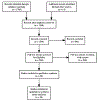Pediatric May-Thurner Syndrome-Systematic review and individual patient data meta-analysis
- PMID: 33651481
- PMCID: PMC8126469
- DOI: 10.1111/jth.15284
Pediatric May-Thurner Syndrome-Systematic review and individual patient data meta-analysis
Abstract
Background: The outcomes of deep vein thrombosis (DVT) in children with May-Thurner Syndrome (MTS) remain unclear.
Objectives: This systematic review and patient-level meta-analysis aims to describe the outcomes of children with MTS presenting with DVT.
Methods: A systematic review of the published literature was performed. Data related to patients <18 years diagnosed with MTS and DVT was extracted. Risk of bias was assessed using the Murad criteria. Outcomes included vessel patency post-treatment, DVT recurrence, and post-thrombotic syndrome (PTS). Predictive and explanatory models were developed for these outcomes.
Results: In total, 109 cases were identified (age range 4-17 years; 77 females) in 28 studies; 75% of patients had ≥1 additional risk factor for DVT. PTS was seen in 61% of patients, DVT recurrence in 38%, and complete vessel patency post-treatment in 65%. The models developed to predict and explain PTS performed poorly overall. Recurrent thrombosis (adjusted for age and patency) predicted PTS (odds ratio [OR] 3.36, 95% confidence interval [CI] 1.28-8.82). DVT management strategies (adjusted for age and DVT characteristics) predicted vessel patency (OR 2.10, 95% CI 1.43-3.08). Lack of complete vessel patency (adjusted for age and thrombophilia) predicted recurrent DVT (OR 2.70, 95% CI 1.09-6.67). Sensitivity analyses showed the same direction of effects for all outcomes.
Conclusions: PTS and DVT recurrence occur frequently in pediatric MTS. PTS prediction is complex and it was not possible to identify early predictors to guide clinical practice. Use of imaging-guided therapy and thrombus burden predicted venous patency, and lack of patency predicted DVT recurrence.
Keywords: anticoagulants; iliac vein compression; iliac vein lesion; post-phlebitic syndrome; post-thrombotic syndrome.
© 2021 International Society on Thrombosis and Haemostasis.
Conflict of interest statement
CONFLICTS OF INTEREST
The authors have no conflicts to declare.
Figures




References
-
- Eklof B, Perrin M, Delis KT, et al. Updated terminology of chronic venous disorders: the VEIN-TERM transatlantic interdisciplinary consensus document. J Vasc Surg. 2009;49:498–501. - PubMed
-
- Virchow R. Ueber die Erweiterung kleinerer Gefäfse: Hierzu Tab. IV. Arch Für Pathol Anat Physiol Für Klin Med. 1851;3(3):427–462.
-
- May R, Thurner J. The cause of the predominantly sinistral occurrence of thrombosis of the pelvic veins. Angiology. 1957;8(5):419–427. - PubMed
-
- May R, Thurner J. A vascular spur in the vena iliaca communis sinistra as a cause of predominantly left-sided thrombosis of the pelvic veins. Z Kreislaufforsch. 1956;45(23–24):912–922. - PubMed
-
- Plate G, Ohlin P, Eklöf B. Pulmonary embolism in acute iliofemoral venous thrombosis. Br J Surg. 1985;72(11):912–915. - PubMed
Publication types
MeSH terms
Grants and funding
LinkOut - more resources
Full Text Sources
Other Literature Sources
Medical

